Examination of Factors Affecting Turnover Rate and Organizational Performance
Added on 2023-01-04
45 Pages11325 Words82 Views
Running head: INDUSTRY RESEARCH REPORT
Industry Research Report
Name of the student
Name of the university
Author note
Industry Research Report
Name of the student
Name of the university
Author note
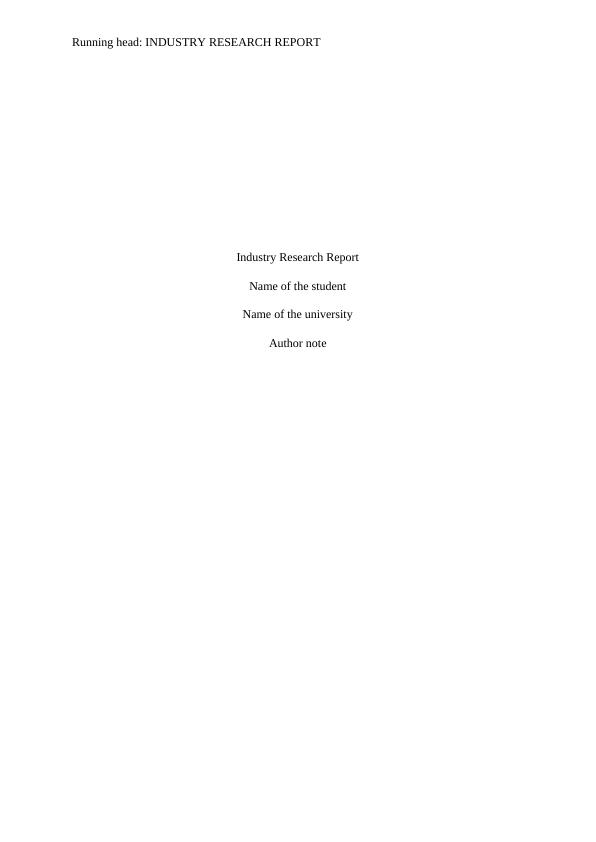
INDUSTRY RESEARCH REPORT1
Executive Summary
This research had examined the turnover issue faced by the industry partner Plaza Premium
Lounge. The research had developed objectives, research questions and hypotheses based on
the problem identified and analysis of the past literature. The critical analysis of the past
literature had facilitated in developing a conceptual framework. The research had used a
single research design where positivist view has been used to perform quantitative analysis of
data and test the hypotheses. The findings suggest that the organisation had issues with
employee turnover and the majority of the employees working in the Plaza premium lounge
in Sydney are not at all satisfied with working environment and the compensation package.
Moreover, the management had also been reluctant in acknowledging their efforts.
Executive Summary
This research had examined the turnover issue faced by the industry partner Plaza Premium
Lounge. The research had developed objectives, research questions and hypotheses based on
the problem identified and analysis of the past literature. The critical analysis of the past
literature had facilitated in developing a conceptual framework. The research had used a
single research design where positivist view has been used to perform quantitative analysis of
data and test the hypotheses. The findings suggest that the organisation had issues with
employee turnover and the majority of the employees working in the Plaza premium lounge
in Sydney are not at all satisfied with working environment and the compensation package.
Moreover, the management had also been reluctant in acknowledging their efforts.
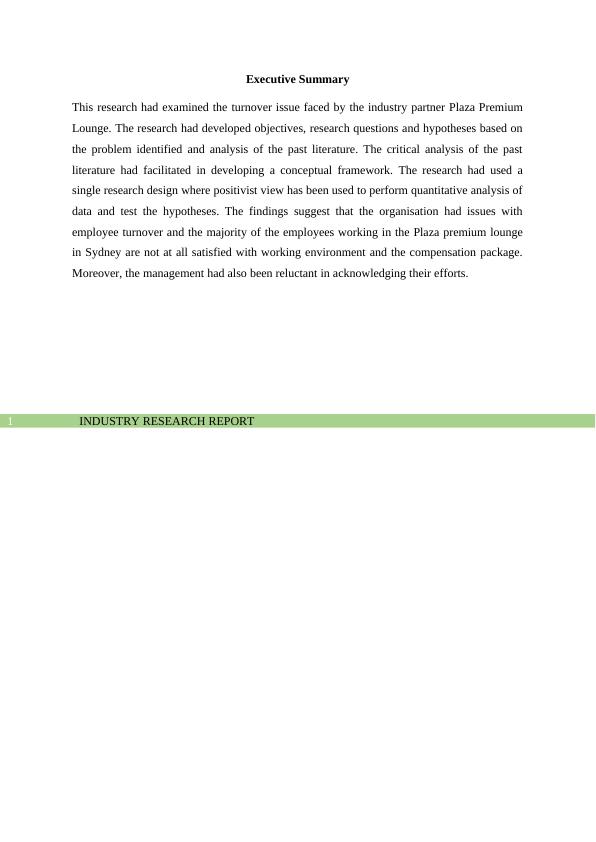
INDUSTRY RESEARCH REPORT2
Table of Contents
Chapter 1: Introduction..............................................................................................................4
1.0 Introduction......................................................................................................................4
1.1 Background of the study..................................................................................................4
1.2 Rationale..........................................................................................................................5
1.3 Research objective...........................................................................................................5
1.4 Research question.............................................................................................................5
1.5 Research hypothesis.........................................................................................................5
1.5 Summary..........................................................................................................................6
Chapter 2: Literature review......................................................................................................7
2.0 Introduction......................................................................................................................7
2.1 Employee turnover...........................................................................................................7
2.2 Organisational performance.............................................................................................9
2.3 Impact of employee turnover on organisational performance.......................................10
2.3.1 Financial performance.................................................................................................10
2.3.2 Productivity and efficiency.........................................................................................11
2.3.3 Customer satisfaction and quality attributes...............................................................11
2.3.4 Product development and innovation..........................................................................12
2.4 Conceptual framework...................................................................................................12
2.5 Literature gap.................................................................................................................13
2.6 Summary........................................................................................................................13
Chapter 3: Research methodology...........................................................................................14
3.0 Introduction....................................................................................................................14
3.1 Research Philosophy......................................................................................................14
3.2 Research Approach........................................................................................................14
3.3 Research Design.............................................................................................................14
3.4 Data Collection and Analysis.........................................................................................15
Table of Contents
Chapter 1: Introduction..............................................................................................................4
1.0 Introduction......................................................................................................................4
1.1 Background of the study..................................................................................................4
1.2 Rationale..........................................................................................................................5
1.3 Research objective...........................................................................................................5
1.4 Research question.............................................................................................................5
1.5 Research hypothesis.........................................................................................................5
1.5 Summary..........................................................................................................................6
Chapter 2: Literature review......................................................................................................7
2.0 Introduction......................................................................................................................7
2.1 Employee turnover...........................................................................................................7
2.2 Organisational performance.............................................................................................9
2.3 Impact of employee turnover on organisational performance.......................................10
2.3.1 Financial performance.................................................................................................10
2.3.2 Productivity and efficiency.........................................................................................11
2.3.3 Customer satisfaction and quality attributes...............................................................11
2.3.4 Product development and innovation..........................................................................12
2.4 Conceptual framework...................................................................................................12
2.5 Literature gap.................................................................................................................13
2.6 Summary........................................................................................................................13
Chapter 3: Research methodology...........................................................................................14
3.0 Introduction....................................................................................................................14
3.1 Research Philosophy......................................................................................................14
3.2 Research Approach........................................................................................................14
3.3 Research Design.............................................................................................................14
3.4 Data Collection and Analysis.........................................................................................15
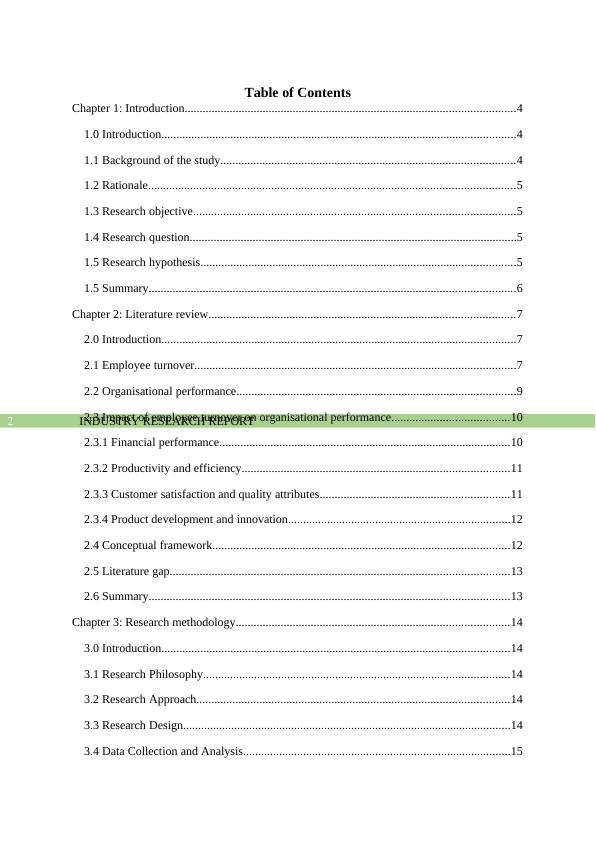
INDUSTRY RESEARCH REPORT3
3.5 Sampling technique........................................................................................................15
3.6 Reliability and Validity..................................................................................................15
3.7 Ethical consideration......................................................................................................16
Chapter 4: Findings and Analysis............................................................................................17
4.0 Introduction....................................................................................................................17
4.1 Reliability and Validity test...........................................................................................17
4.2 Frequency Table.............................................................................................................18
4.2.1 Satisfaction..............................................................................................................20
4.2.2 Rate of staff turnover..............................................................................................21
4.2.3 Work-life balance....................................................................................................22
4.2.4 Wastefulness of resources.......................................................................................23
4.2.5 Costs........................................................................................................................24
4.2.6 Organisational performance....................................................................................26
4.2.7 Mitigation techniques..............................................................................................27
4.3 Correlation Analysis.......................................................................................................29
4.4 Regression Analysis.......................................................................................................31
4.5 Summary........................................................................................................................35
Chapter 5: Conclusion..............................................................................................................36
5.0 Conclusion......................................................................................................................36
5.1 Recommendation............................................................................................................36
References................................................................................................................................38
Appendix..................................................................................................................................41
3.5 Sampling technique........................................................................................................15
3.6 Reliability and Validity..................................................................................................15
3.7 Ethical consideration......................................................................................................16
Chapter 4: Findings and Analysis............................................................................................17
4.0 Introduction....................................................................................................................17
4.1 Reliability and Validity test...........................................................................................17
4.2 Frequency Table.............................................................................................................18
4.2.1 Satisfaction..............................................................................................................20
4.2.2 Rate of staff turnover..............................................................................................21
4.2.3 Work-life balance....................................................................................................22
4.2.4 Wastefulness of resources.......................................................................................23
4.2.5 Costs........................................................................................................................24
4.2.6 Organisational performance....................................................................................26
4.2.7 Mitigation techniques..............................................................................................27
4.3 Correlation Analysis.......................................................................................................29
4.4 Regression Analysis.......................................................................................................31
4.5 Summary........................................................................................................................35
Chapter 5: Conclusion..............................................................................................................36
5.0 Conclusion......................................................................................................................36
5.1 Recommendation............................................................................................................36
References................................................................................................................................38
Appendix..................................................................................................................................41
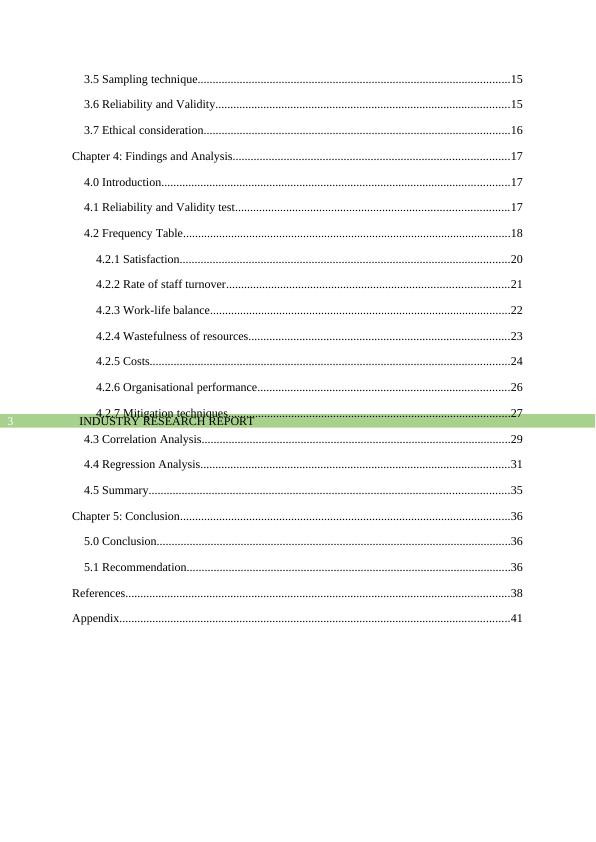
INDUSTRY RESEARCH REPORT4
Topic: Examination of the factors affecting the turnover rate and its impact on organizational
performance- “A case study of Plaza premium Group”
Chapter 1: Introduction
1.0 Introduction
This report examines the issues faced by Plaza Premium Group in effectively
managing their workforce, improving retention rate and reduce the turnover rate. Hospitality
industry has had the highest employee turnover among all other sectors due to the stressful
work environment and inadequate compensation package. The chosen organization is no
different and I have been able to gather effective information on the issue as I have been
working in the organization since 2017 as a food and Beverage attendant. The research aims
to highlight critical issues that have been left unnoticed in the past.
1.1 Background of the study
There has significant increase in staff turnover in the past three years and survey
conducted on the employees working in the Australian industry has shown that one in every
seven employees or 1.8 million workers in Australia are expected to search for jobs in the
coming year (Pash 2018). The survey also showed that more than 60% of the employers in
Australia have seen significant increase in staff turnover with an average turnover at 15%
(Pash 2018). Moreover, managers suggest that even though all the companies have policies
to mitigate and avoid turnover within their organization, it is expected to go up within the
next year. The evaluation of the wellness and appreciation programs have shown that only
50% of the organization have implemented such policies (Pash 2018). On the other hand,
more than half of the firms does not offer any training and development opportunities to their
employees and the salaries of the workforce are not reviewed on daily basis. Staff turnover
causes significant setback for companies through loss of revenue, morale and productivity.
Therefore, it is essential for organisations to secure a stable pipeline of talented and skilled
employees by developing effective employee retention policies. This highlights the need for
developing effective staff engagement policies on retention and acquisition of highly skilled
employees.
The situation is no different in case of the industry partner, Plaza Premium Group.
The company has been providing best value added services in an airport. It includes shower
rooms, massages, food and beverages and other services. The company operates in the global
market in 35 international airports and employed more than 3500 employees. However, the
Topic: Examination of the factors affecting the turnover rate and its impact on organizational
performance- “A case study of Plaza premium Group”
Chapter 1: Introduction
1.0 Introduction
This report examines the issues faced by Plaza Premium Group in effectively
managing their workforce, improving retention rate and reduce the turnover rate. Hospitality
industry has had the highest employee turnover among all other sectors due to the stressful
work environment and inadequate compensation package. The chosen organization is no
different and I have been able to gather effective information on the issue as I have been
working in the organization since 2017 as a food and Beverage attendant. The research aims
to highlight critical issues that have been left unnoticed in the past.
1.1 Background of the study
There has significant increase in staff turnover in the past three years and survey
conducted on the employees working in the Australian industry has shown that one in every
seven employees or 1.8 million workers in Australia are expected to search for jobs in the
coming year (Pash 2018). The survey also showed that more than 60% of the employers in
Australia have seen significant increase in staff turnover with an average turnover at 15%
(Pash 2018). Moreover, managers suggest that even though all the companies have policies
to mitigate and avoid turnover within their organization, it is expected to go up within the
next year. The evaluation of the wellness and appreciation programs have shown that only
50% of the organization have implemented such policies (Pash 2018). On the other hand,
more than half of the firms does not offer any training and development opportunities to their
employees and the salaries of the workforce are not reviewed on daily basis. Staff turnover
causes significant setback for companies through loss of revenue, morale and productivity.
Therefore, it is essential for organisations to secure a stable pipeline of talented and skilled
employees by developing effective employee retention policies. This highlights the need for
developing effective staff engagement policies on retention and acquisition of highly skilled
employees.
The situation is no different in case of the industry partner, Plaza Premium Group.
The company has been providing best value added services in an airport. It includes shower
rooms, massages, food and beverages and other services. The company operates in the global
market in 35 international airports and employed more than 3500 employees. However, the
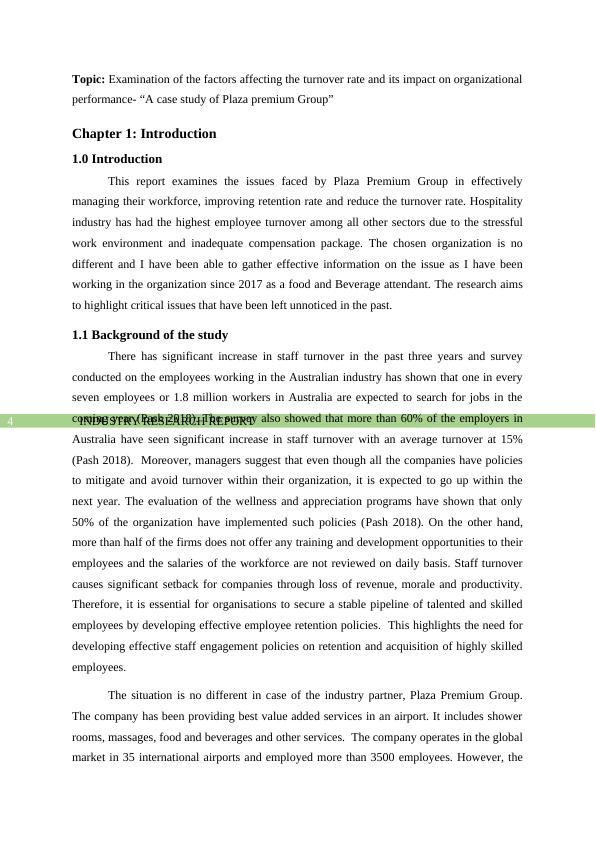
INDUSTRY RESEARCH REPORT5
research has addressed the issues faced by lounge in Sydney Airport which has seen a
significant in turnover of staffs.
1.2 Rationale
This research has chosen the particular topic as the industry has been facing issues in
retaining their existing employees. The lounge witnessed departure of 25 of their staffs in the
fiscal year of 2018 which amounts to atleast two staffs every month. This is quite for even the
employees working in the hospitality industry. However, employees working in lounges
consist of casual, part time and full time employees and if all these employees are taken into
consideration, the results are relatively skewed. The focus needs to be on the full time
employees and converting the part-time and causal employees into full time employees. This
is possible by developing effective employee engagement policies addressing the current
needs of the workforce. Therefore, the purpose of the research is to increase awareness of the
management of Plaza Premium lounge in Sydney Airport so that they can be take remedial
measures to reduce turnover rate within the organization.
1.3 Research objective
The objective of the current industry report are as follows:
To examine the factors affecting the staff turnover in Plaza Premium Group
To investigate the impact of high turnover rate on the organizational performance in
Plaza Premium Group
To provide suitable recommendations to improve the retention rate of workforce in
Plaza Premium Group
1.4 Research question
What are the different factors affecting the staff turnover in Plaza Premium Group?
How does Plaza Premium Group impacted due to high turnover rate?
1.5 Research hypothesis
H01: There is no impact of high employee turnover on the productivity of Plaza Premium
Group
H11: There is significant negative impact of employee turnover on the productivity of Plaza
Premium Group
research has addressed the issues faced by lounge in Sydney Airport which has seen a
significant in turnover of staffs.
1.2 Rationale
This research has chosen the particular topic as the industry has been facing issues in
retaining their existing employees. The lounge witnessed departure of 25 of their staffs in the
fiscal year of 2018 which amounts to atleast two staffs every month. This is quite for even the
employees working in the hospitality industry. However, employees working in lounges
consist of casual, part time and full time employees and if all these employees are taken into
consideration, the results are relatively skewed. The focus needs to be on the full time
employees and converting the part-time and causal employees into full time employees. This
is possible by developing effective employee engagement policies addressing the current
needs of the workforce. Therefore, the purpose of the research is to increase awareness of the
management of Plaza Premium lounge in Sydney Airport so that they can be take remedial
measures to reduce turnover rate within the organization.
1.3 Research objective
The objective of the current industry report are as follows:
To examine the factors affecting the staff turnover in Plaza Premium Group
To investigate the impact of high turnover rate on the organizational performance in
Plaza Premium Group
To provide suitable recommendations to improve the retention rate of workforce in
Plaza Premium Group
1.4 Research question
What are the different factors affecting the staff turnover in Plaza Premium Group?
How does Plaza Premium Group impacted due to high turnover rate?
1.5 Research hypothesis
H01: There is no impact of high employee turnover on the productivity of Plaza Premium
Group
H11: There is significant negative impact of employee turnover on the productivity of Plaza
Premium Group
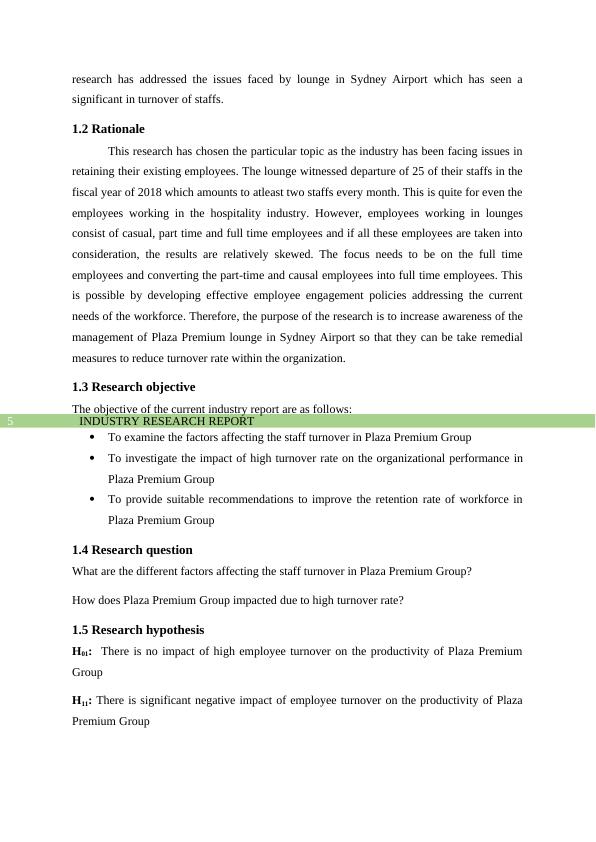
INDUSTRY RESEARCH REPORT6
H02: There is no impact of high employee turnover on the financial Performance of Plaza
Premium Group
H12: There is significant negative impact of employee turnover on the Financial Performance
of Plaza Premium Group
H03: There is no impact of high employee turnover on the quality attributes and customer
satisfaction of Plaza Premium Group
H13: There is significant negative impact of employee turnover on the quality attributes and
customer satisfaction of Plaza Premium Group
H04: There is no impact of high employee turnover on the product development and
innovation of Plaza Premium Group
H14: There is significant negative impact of employee turnover on product development and
innovation of Plaza Premium Group
1.5 Summary
This chapter has clearly described the research problem in detail to highlight the key
reason for choosing the current research topic. The exploration of the research topic has
highlighted staff turnover has risen in the past three years in the Australian companies. The
report has developed research questions based on the overarching problems along with the
hypothesis to be addressed. The reason for choosing the topic has also been provided in
detail which has highlighted the purpose of performing the study. The next chapter has
developed literature based on the objectives and the research by evaluating the past studies on
employee turnover in the hospitality industry. The research has chosen specific theories that
has facilitated in developing frameworks for addressing the research.
H02: There is no impact of high employee turnover on the financial Performance of Plaza
Premium Group
H12: There is significant negative impact of employee turnover on the Financial Performance
of Plaza Premium Group
H03: There is no impact of high employee turnover on the quality attributes and customer
satisfaction of Plaza Premium Group
H13: There is significant negative impact of employee turnover on the quality attributes and
customer satisfaction of Plaza Premium Group
H04: There is no impact of high employee turnover on the product development and
innovation of Plaza Premium Group
H14: There is significant negative impact of employee turnover on product development and
innovation of Plaza Premium Group
1.5 Summary
This chapter has clearly described the research problem in detail to highlight the key
reason for choosing the current research topic. The exploration of the research topic has
highlighted staff turnover has risen in the past three years in the Australian companies. The
report has developed research questions based on the overarching problems along with the
hypothesis to be addressed. The reason for choosing the topic has also been provided in
detail which has highlighted the purpose of performing the study. The next chapter has
developed literature based on the objectives and the research by evaluating the past studies on
employee turnover in the hospitality industry. The research has chosen specific theories that
has facilitated in developing frameworks for addressing the research.

INDUSTRY RESEARCH REPORT7
Chapter 2: Literature review
2.0 Introduction
This chapter has examined the past literature on employee turnover to underpin its
impacts on organisational performance. It has also depicted the critical factors affecting staff
turnover. Employee turnover has been analysed and evaluated more rigorously since the
1970s and the relationship between the parameters have been evaluated in the past studies.
Employee turnover is one of the key issue faced by the organisations and with increase in
scarcity of skilled employees in the global market, effective management of workforce is one
of the major concerns of the organisations (Kim 2014). The research has tried to develop a
multifaceted understanding of the elements, concerns and relationship among the variables.
Even though it is one of the most explored topics of research, firms have been reluctant about
their choices in policies which hampered them in terms of service quality and performance.
This is because of the constant in change in nature of the working environment due to the
widespread implementation of globalisation. This has made the employee turnover to be one
of the most dynamic in managing human resources.
2.1 Employee turnover
Abbas et al. (2014) states that employee turnover can be defined as the proportion of
employees or staffs leaving an organisation within a certain time period. This data is
expressed in terms of percentage of employees leaving the organisation in comparison to the
total workforce. Irefin and Mechanic (2014) considers turnover of staffs as the rate of
substitution of workers within a given period of time for the organisations. Staff turnover can
be involuntary or voluntary. Voluntary turnover consist of employees leaving jobs on their
own, employees retiring or leaving due to natural causes like death. On the contrary,
involuntary turnover refers to situations where employees are laid off or transferred.
Kang, Gatlingand Kim (2015) performed a research and found out that job
satisfaction is the central element of influencing the turnover within the organisation. As
stated by Peretz, Levi and Fried (2015), job satisfaction is the state of fulfilment where the
expectation of the employees are met. This is an effect from the cognitive results due to work
benefits and nature of the job. By referring to the research conducted by Bakotić (2016), job
satisfaction has been considered as a key factors in reducing turnover intention of employees.
On the contrary, Karatepe and Vatankhah (2014) states that jobs satisfaction is a tool for
predicting the expected turnover rate of the business entities. In this light of context, the
Chapter 2: Literature review
2.0 Introduction
This chapter has examined the past literature on employee turnover to underpin its
impacts on organisational performance. It has also depicted the critical factors affecting staff
turnover. Employee turnover has been analysed and evaluated more rigorously since the
1970s and the relationship between the parameters have been evaluated in the past studies.
Employee turnover is one of the key issue faced by the organisations and with increase in
scarcity of skilled employees in the global market, effective management of workforce is one
of the major concerns of the organisations (Kim 2014). The research has tried to develop a
multifaceted understanding of the elements, concerns and relationship among the variables.
Even though it is one of the most explored topics of research, firms have been reluctant about
their choices in policies which hampered them in terms of service quality and performance.
This is because of the constant in change in nature of the working environment due to the
widespread implementation of globalisation. This has made the employee turnover to be one
of the most dynamic in managing human resources.
2.1 Employee turnover
Abbas et al. (2014) states that employee turnover can be defined as the proportion of
employees or staffs leaving an organisation within a certain time period. This data is
expressed in terms of percentage of employees leaving the organisation in comparison to the
total workforce. Irefin and Mechanic (2014) considers turnover of staffs as the rate of
substitution of workers within a given period of time for the organisations. Staff turnover can
be involuntary or voluntary. Voluntary turnover consist of employees leaving jobs on their
own, employees retiring or leaving due to natural causes like death. On the contrary,
involuntary turnover refers to situations where employees are laid off or transferred.
Kang, Gatlingand Kim (2015) performed a research and found out that job
satisfaction is the central element of influencing the turnover within the organisation. As
stated by Peretz, Levi and Fried (2015), job satisfaction is the state of fulfilment where the
expectation of the employees are met. This is an effect from the cognitive results due to work
benefits and nature of the job. By referring to the research conducted by Bakotić (2016), job
satisfaction has been considered as a key factors in reducing turnover intention of employees.
On the contrary, Karatepe and Vatankhah (2014) states that jobs satisfaction is a tool for
predicting the expected turnover rate of the business entities. In this light of context, the
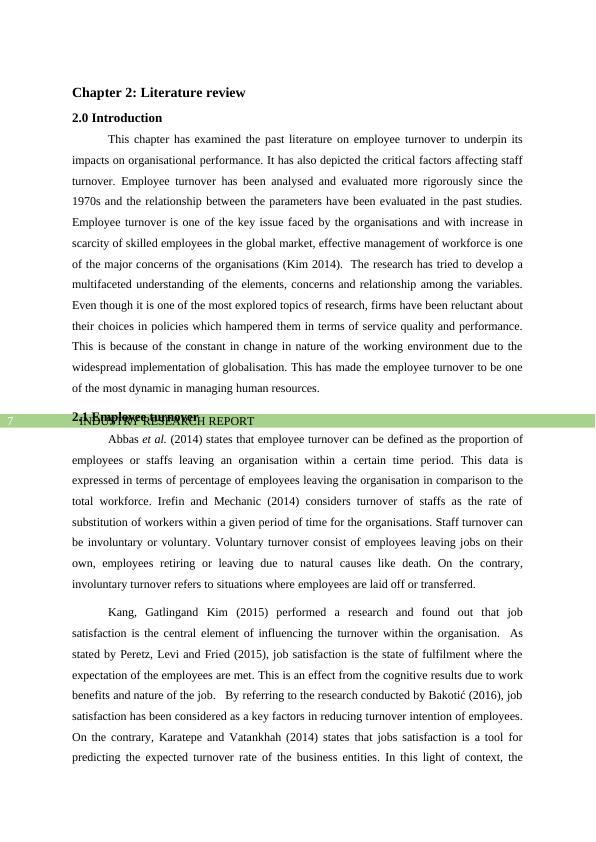
End of preview
Want to access all the pages? Upload your documents or become a member.
Related Documents
Evaluating the Impact of Lack of Motivation on Staff Performance and Event Successlg...
|51
|12688
|198
The Impact of Fuel Price on SMEs in Omanlg...
|49
|9506
|327
Relationship between Flexible Work Arrangements and Employees Job Satisfaction through Work-Family Enrichmentlg...
|51
|13679
|93
Guerrilla Marketing and its Effects on Consumer Behaviour and Brand Awarenesslg...
|105
|24470
|63
Examination of the Process and Issues of Recruitment in the Front Office Department- A case study of Accor hotel - Mantra Hotelslg...
|62
|15216
|279
Impact of Leadership style on Employee Performance: A case study of HSBClg...
|87
|19011
|452